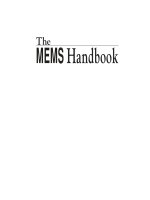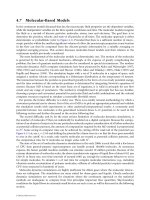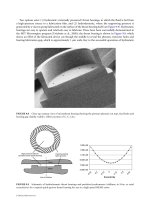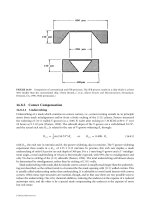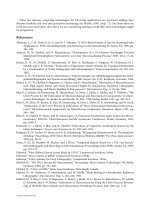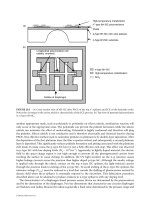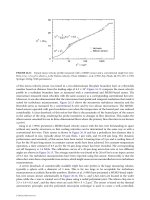The MEMS Handbook (1st Ed) - M. Gad el Hak Part 3 pptx
Bạn đang xem bản rút gọn của tài liệu. Xem và tải ngay bản đầy đủ của tài liệu tại đây (141.02 KB, 5 trang )
© 2002 by CRC Press LLC
N
A
Avogadro’s number
P perimeter
Q flux
PO Poiseuille number
R
flow
flow resistance
R
elec
electrical resistance
Re Reynolds number
Re
crit
critical Reynolds number
St Strouhal number
T temperature
U
s
characteristic velocity scale
area-averaged velocity
V voltage
V
1
molar volume
V
i
time-dependent voltage applied to a reservoir “well”
W channel width
STP standard temperature and pressure
References
Adamson, A.W., and Gast, A.P. (1997) Physical Chemistry of Surfaces, sixth edition, John Wiley & Sons,
New York.
Alarie, J.P., Jacobson, S.C., Culbertson, C.T. et al. (2000) “Effects of the Electric Field Distribution on
Microchip Valving Performance,” Electrophoresis 21, pp. 100–106.
Anderson, J.L., and Idol, W.K. (1985) “Electroosmosis Through Pores with Nonuniformly Charged Walls,”
Chem. Eng. Commun. 38, pp. 93–106.
Arkilic, E.B., Schmidt, M.A., and Breuer, K.S. (1997) “Gaseous Slip Flow in Long Microchannels,” J. MEMS
6, pp. 167–178.
Baker, D.R. (1995) Capillary Electrophoresis, Techniques in Analytical Chemistry Series, John Wiley &
Sons, New York.
Bharadwaj, R., and Santiago, J.G. (2000) unpublished results, Stanford University, Stanford, CA.
Bianchi, F., Ferrigno, R., and Girault, H.H. (2000) “Finite Element Simulation of an Electroosmotic-
Driven Flow Division at a T-Junction of Microscale Dimensions,” Anal. Chem. 72, pp. 1987–1993.
Bosse, M.A., and Arce, P. (2000) “Role of Joule Heating in Dispersive Mixing Effects in Electrophoretic
Cells: Convective-Diffusive Transport Aspects,” Electrophoresis 21, pp. 1026–1033.
Brandner, J., Fichtner, M., Schygulla, U., and Schubert, K. (2000) “Improving the Efficiency of Micro
Heat Exchangers and Reactors,” in Proc. 4th Int. Conf. Microreaction Technology, AIChE, March
5–9, Atlanta, GA, pp. 244–249.
Branebjerg, J., Fabius, B., and Gravesen, P. (1995) “Application of Miniature Analyzers: From Microfluidic
Components to
µTAS,” in Micro Total Analysis Systems, eds. A. van den Berg and P. Bergveld,
Kluwer Academic, Dordrecht, pp. 141–151.
Branebjerg, J., Gravesen, P., Krog, J.P., and Nielsen, C.R. (1996) “Fast Mixing by Lamination,” in Proc. 9th
Annual Workshop of Micro Electro Mechanical Systems, February 11–15, San Diego, CA, pp. 441–446.
Bridgman, P.W. (1923) “The Thermal Conductivity of Liquids Under Pressure,” Proc. Am. Acad. Arts Sci.
59, pp. 141–169.
Brody, J.P., Yager, P., Goldstein, R.E., and Austin, R.H. (1996) “Biotechnology at Low Reynolds Numbers,”
Biophys. J. 71, pp. 3430–3441.
Burgreen, D., and Nakache, F.R. (1964) “ElectroKinetic Flow in Ultrafine Capillary Slits,” J. Phys. Chem.
68, pp. 1084–1091.
Chen, Z., Milner, T.E., Dave, D., and Nelson, J.S. (1997) “Optical Doppler Tomographic Imaging of Fluid
Flow Velocity in Highly Scattering Media,” Opt. Lett. 22, pp. 64–66.
U
© 2002 by CRC Press LLC
N
A
Avogadro’s number
P perimeter
Q flux
PO Poiseuille number
R
flow
flow resistance
R
elec
electrical resistance
Re Reynolds number
Re
crit
critical Reynolds number
St Strouhal number
T temperature
U
s
characteristic velocity scale
area-averaged velocity
V voltage
V
1
molar volume
V
i
time-dependent voltage applied to a reservoir “well”
W channel width
STP standard temperature and pressure
References
Adamson, A.W., and Gast, A.P. (1997) Physical Chemistry of Surfaces, sixth edition, John Wiley & Sons,
New York.
Alarie, J.P., Jacobson, S.C., Culbertson, C.T. et al. (2000) “Effects of the Electric Field Distribution on
Microchip Valving Performance,” Electrophoresis 21, pp. 100–106.
Anderson, J.L., and Idol, W.K. (1985) “Electroosmosis Through Pores with Nonuniformly Charged Walls,”
Chem. Eng. Commun. 38, pp. 93–106.
Arkilic, E.B., Schmidt, M.A., and Breuer, K.S. (1997) “Gaseous Slip Flow in Long Microchannels,” J. MEMS
6, pp. 167–178.
Baker, D.R. (1995) Capillary Electrophoresis, Techniques in Analytical Chemistry Series, John Wiley &
Sons, New York.
Bharadwaj, R., and Santiago, J.G. (2000) unpublished results, Stanford University, Stanford, CA.
Bianchi, F., Ferrigno, R., and Girault, H.H. (2000) “Finite Element Simulation of an Electroosmotic-
Driven Flow Division at a T-Junction of Microscale Dimensions,” Anal. Chem. 72, pp. 1987–1993.
Bosse, M.A., and Arce, P. (2000) “Role of Joule Heating in Dispersive Mixing Effects in Electrophoretic
Cells: Convective-Diffusive Transport Aspects,” Electrophoresis 21, pp. 1026–1033.
Brandner, J., Fichtner, M., Schygulla, U., and Schubert, K. (2000) “Improving the Efficiency of Micro
Heat Exchangers and Reactors,” in Proc. 4th Int. Conf. Microreaction Technology, AIChE, March
5–9, Atlanta, GA, pp. 244–249.
Branebjerg, J., Fabius, B., and Gravesen, P. (1995) “Application of Miniature Analyzers: From Microfluidic
Components to
µTAS,” in Micro Total Analysis Systems, eds. A. van den Berg and P. Bergveld,
Kluwer Academic, Dordrecht, pp. 141–151.
Branebjerg, J., Gravesen, P., Krog, J.P., and Nielsen, C.R. (1996) “Fast Mixing by Lamination,” in Proc. 9th
Annual Workshop of Micro Electro Mechanical Systems, February 11–15, San Diego, CA, pp. 441–446.
Bridgman, P.W. (1923) “The Thermal Conductivity of Liquids Under Pressure,” Proc. Am. Acad. Arts Sci.
59, pp. 141–169.
Brody, J.P., Yager, P., Goldstein, R.E., and Austin, R.H. (1996) “Biotechnology at Low Reynolds Numbers,”
Biophys. J. 71, pp. 3430–3441.
Burgreen, D., and Nakache, F.R. (1964) “ElectroKinetic Flow in Ultrafine Capillary Slits,” J. Phys. Chem.
68, pp. 1084–1091.
Chen, Z., Milner, T.E., Dave, D., and Nelson, J.S. (1997) “Optical Doppler Tomographic Imaging of Fluid
Flow Velocity in Highly Scattering Media,” Opt. Lett. 22, pp. 64–66.
U
© 2002 by CRC Press LLC
7
Burnett Simulations of
Flows in Microdevices
7.1 Abstract
7.2 Introduction
7.3 History of Burnett Equations
7.4 Governing Equations
7.5 Wall-Boundary Conditions
7.6 Linearized Stability Analysis of Burnett Equations
7.7 Numerical Method
7.8 Numerical Simulations
Application to Hypersonic Shock Structure • Application to
Two-Dimensional Hypersonic Blunt Body Flow • Application
to Axisymmetric Hypersonic Blunt Body Flow • Application to
NACA 0012 Airfoil • Subsonic Flow in a Microchannel •
Supersonic Flow in a Microchannel
7.9 Conclusions
Nomenclature
7.1 Abstract
In recent years, interest in computing gas flows at high Knudsen numbers in microdevices has been
considerable. At low Knudsen numbers, models based on the solution of compressible Navier–Stokes
equations with slip-boundary conditions are adequate. At high Knudsen numbers, either higher order
(beyond Navier–Stokes) continuum equations or the particle methods such as direct simulation Monte
Carlo (DSMC) are employed to compute the flows. Higher order continuum approximations are based
on the Chapman–Enskog expansion of the Boltzmann equation (leading to Burnett and super-Burnett
equations), or moment methods based on taking the moments of the Boltzmann equation with flow
variables (leading to Grad’s 13-moment equations or Levermore’ moment equations, for example). In
this chapter, the history of the Burnett equations and a variety of Burnett approximations (conventional
Burnett equations, augmented Burnett equations and BGK–Burnett equations) are presented. The phys-
ical and numerical issues related to these approximations are discussed. Traditionally, Burnett equations
have been employed to compute the high-altitude, low-density hypersonic flows in the continuum–
transition regime. Therefore, some Navier–Stokes and Burnett solutions are presented for hypersonic
shock structure and blunt-body flows and rarefied subsonic airfoil flow to provide some perspective on
the applicability and suitability of Burnett equations for computing flows at high Knudsen numbers.
Calculations are then presented for both subsonic and supersonic flows in microchannels. These com-
putations are compared with Navier–Stokes solutions with slip-boundary conditions and DSMC solutions.
Ramesh K. Agarwal
Wichita State University
Keon-Young Yun
Wichita State University
© 2002 by CRC Press LLC
8
Molecular-Based
Microfluidic Simulation
Models
8.1 Abstract
8.2 Introduction
8.3 Gas Flows
Molecular Magnitudes • An Overview of the Direct
Simulation Monte Carlo Method • Limitations, Error Sources
and Disadvantages of the DSMC Approach • Some
DSMC-Based Gas Microflow Results • Recent Advances in
the DSMC Method • DSMC Coupling with Continuum
Equations • Boltzmann Equation Research • Hybrid
Boltzmann/Continuum Simulation Methods • Lattice
Boltzmann Methods
8.4 Liquid and Dense Gas Flows
Electric Double Layer and Electrokinetic Effects • The Electro-
Osmotic Flow • Molecular Dynamics Method • Treatment of
Surfaces
8.5 Summary and Conclusions
8.1 Abstract
This chapter concentrates on molecular-based numerical simulation methods for liquid and gas micro-
flows. After a brief introduction of molecular magnitudes, a detailed coverage of the direct simulation
Monte Carlo method for gas flows is presented. Brief descriptions of other simulation methodologies,
such as the Boltzmann and lattice Boltzmann methods and the molecular dynamics method, are also
given. Throughout the chapter, extensive references to books, research and review articles are supplied
with the perspective of guiding the reader toward recent literature.
8.2 Introduction
Simulation of microscale thermal fluidic transport is gaining importance due to the emerging technol-
ogies of the 21st century, such as microelectromechanical systems (MEMS) and nanotechnologies. Min-
iaturization of device scales, for the first time, has enabled the possibility of integration of sensing,
computation, actuation, control, communication and power generation within the same microchip. The
small size, light weight and high-durability of MEMS, combined with the mass-fabrication ability, result
in low-cost systems with a wide variety of applications spanning from control systems to advanced energy
systems to biological, medical and chemical applications. Despite these diverse prospects and fast growth
Ali Beskok
Texas A&M University
© 2002 by CRC Press LLC
9
Lubrication in MEMS
9.1 Introduction
Objectives and Outline
9.2 Fundamental Scaling Issues
The Cube-Square Law • Applicability of the Continuum
Hypothesis • Surface Roughness
9.3 Governing Equations for Lubrication
9.4 Couette-Flow Damping
Limit of Molecular Flow
9.5 Squeeze-Film Damping
Derivation of Governing Equations • Effects of Vent
Holes • Reduced-Order Models for Complex Geometries
9.6 Lubrication in Rotating Devices
9.7 Constraints on MEMS Bearing Geometries
Device Aspect Ratio • Minimum Etchable Clearance
9.8 Thrust Bearings
9.9 Journal Bearings
Hydrodynamic Operation • Static Journal Bearing
Behavior • Journal Bearing Stability • Advanced Journal
Bearing Designs • Side Pressurization • Hydrostatic
Operation
9.10 Fabrication Issues
Cross-Wafer Uniformity • Deep Etch Uniformity • Material
Properties
9.11 Tribology and Wear
Stiction • The Tribology of Silicon
9.12 Conclusions
Acknowledgments
9.1 Introduction
As microengineering technology continues to advance, driven by increasingly complex and capable micro-
fabrication and materials technologies, the need for greater sophistication in microelectromechanical
systems (MEMS) design will increase. Fluid film lubrication has been a critical issue from the outset of
MEMS development, particularly in the prediction and control of viscous damping in vibrating devices
such as accelerometers and gyros. Much attention has been showered on the development of models for
accurate prediction of viscous damping and of fabrication techniques for minimizing the damping (which
destroys the quality, or
Q
-factor, of a resonant system). In addition to the development and optimization
of these oscillatory devices, rotating devices—micromotors, microengines, etc.—have also captured the
attention of MEMS researchers since the early days of MEMS development, and there have been several
demonstrations of micromotors driven by electrostatic forces [Bart et al., 1988; Mehregany et al., 1992;
Nagle and Lang, 1999; Sniegowski and Garcia, 1996]. For the most part these motors were very small,
Kenneth S. Breuer
Brown University


